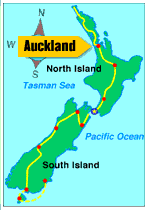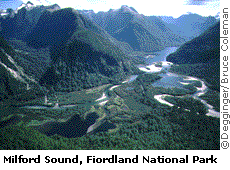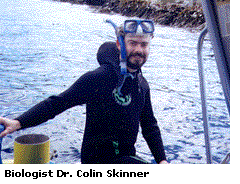 |
About New Zealand |
||
 Imagine a place where the constellations of stars above your head are different from those that you have ever seen, where the night sky can glow with strange swirling lights, and where the cold of winter comes when summer arrives in the United States. Imagine a place where there are volcanoes, mountains, rivers of ice, and deep forests of strange trees, and where insect-eating grubs glow like stars in dark caves. This land is a place of earthquakes and giant sea creatures, where the people were once fierce warriors who worshipped mysterious spirits. This place is not from a fairy tale — it is New Zealand.
Imagine a place where the constellations of stars above your head are different from those that you have ever seen, where the night sky can glow with strange swirling lights, and where the cold of winter comes when summer arrives in the United States. Imagine a place where there are volcanoes, mountains, rivers of ice, and deep forests of strange trees, and where insect-eating grubs glow like stars in dark caves. This land is a place of earthquakes and giant sea creatures, where the people were once fierce warriors who worshipped mysterious spirits. This place is not from a fairy tale — it is New Zealand.
Hundreds of millions of years ago, all the earth's continents were connected into one gigantic landmass. Over millions of years, the landmass broke apart along its tectonic plates. (Tectonic plates are large jigsaw-puzzlelike sections of the earth's crust that move slowly over the hot molten rock below.) New Zealand is positioned where two tectonic plates collide and cause the earth's crust to buckle, resulting in earthquakes. The collision can also produce cracks in the earth's surface where molten rock can push its way out and burst with gas and ash, also known as a volcanic eruption. The isolation of New Zealand from other lands allowed the survival of animals and plants from the time of the dinosaurs. Ancient tree ferns, plants that produce spores rather than seeds, and primitive relatives of pine trees still grow in the forests. Among the unusual creatures that still live in New Zealand are flightless ground-dwelling birds and ancient reptiles that have hardly evolved in the past 220 million years. New Zealand is like a Jurassic Ark, containing the last survivors of a time long passed. On his trek, Colin Skinner walked from the North Island of New Zealand to the tip of the South Island, exploring the magical geography and wildlife — from the top of the Mount Ruapehu volcano, where gas and hot rocks erupt from below the surface of the earth to the weird and wonderful wildlife, like glow worms that live in dark caves. Along the way, he also met Maori people, whose ancestors were the first inhabitants of New Zealand, and learned about their rich culture of songs, art, and spiritual beliefs. Read about Colin's experiences in his field journals and interview transcripts. Check out our New Zealand Web sites to learn more about the country's history, culture, geography, and more! |
|||
 New Zealand is located in the Pacific Ocean, about 1,000 miles southeast of Australia. The country consists of two long main islands — the North Island and the South Island — and tiny Stewart Island located at its southern tip. Colin Skinner chose New Zealand for this science expedition for its diverse geography — like glaciers, rainforests, and volcanoes — as well as its unusual wildlife found nowhere else on earth. Let's look at how New Zealand took form to understand why New Zealand is so unique.
New Zealand is located in the Pacific Ocean, about 1,000 miles southeast of Australia. The country consists of two long main islands — the North Island and the South Island — and tiny Stewart Island located at its southern tip. Colin Skinner chose New Zealand for this science expedition for its diverse geography — like glaciers, rainforests, and volcanoes — as well as its unusual wildlife found nowhere else on earth. Let's look at how New Zealand took form to understand why New Zealand is so unique.